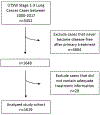Timing, Sites, and Correlates of Lung Cancer Recurrence
- PMID: 31932216
- PMCID: PMC7061059
- DOI: 10.1016/j.cllc.2019.12.001
Timing, Sites, and Correlates of Lung Cancer Recurrence
Abstract
Introduction: Understanding temporal and anatomic patterns of lung cancer recurrence could guide disease management and monitoring. However, these data are not available in population-based datasets and are not routinely recorded in clinical trials.
Materials and methods: We identified cases of stage 1 to 3 lung cancer diagnosed January 1, 2000, to December 31, 2017, in the tumor registry of a National Cancer Institute-designated comprehensive cancer center. For cases with documented disease recurrence, we recorded anatomic site(s) and timing. We estimated time to recurrence using Kaplan-Meier methods. Associations between case characteristics and recurrence features were assessed using univariable and multivariable logistic regression models and Cox regression models.
Results: A total of 1619 cases of stage 1 to 3 lung cancer from 1549 patients were included in the analysis. Of these, 466 (30%) patients developed recurrent lung cancer. The most common type of first recurrence was distant disease, most commonly central nervous system (CNS) (37%). In multivariable analyses, race (P = .02) and primary treatment modality (P < .001) correlated with recurrent disease, whereas tumor histology (P = .004) and primary treatment modality (P < .001) were associated specifically with distant recurrence. Patient age (P = .05) and initial TNM stage (P = .001) correlated with timing of recurrence.
Conclusion: In this single-center series of stage 1 to 3 lung cancer, recurrent disease was associated with race, histology, and treatment modality, and most commonly occurred in the CNS. Modulation of clinical and radiographic disease monitoring according to recurrence risk, timing, and site may offer a means to identify future lung cancer when it remains asymptomatic and highly treatable.
Keywords: Latency; Metastases; Monitoring; Outcomes; Surveillance.
Copyright © 2019 Elsevier Inc. All rights reserved.
Conflict of interest statement
Conflicts of Interest:
The authors have no conflicts of interest to report.
Figures
References
-
- American Cancer Society. Key Statistics for Lung Cancer. https://www.cancer.org/cancer/non-small-cell-lung-cancer/about/key-stati...; 2016. Accessed 04 August 2019.
-
- Surveillance, Epidemiology, and End Results (SEER) Program. Cancer Stat Facts: Lung and Bronchus Cancer. https://seer.cancer.gov/statfacts/html/lungb.html; Accessed 04 August 2019.
Publication types
MeSH terms
Grants and funding
LinkOut - more resources
Full Text Sources
Medical



